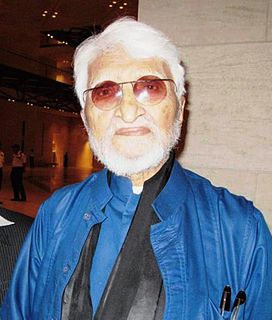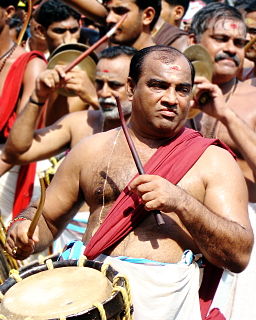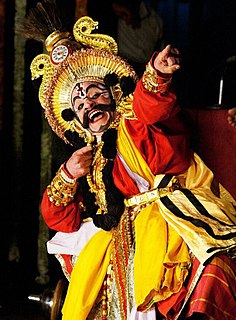
Kalakshetra Foundation, formerly simply Kalakshetra, is an arts and cultural academy dedicated to the preservation of traditional values in Indian art and crafts, especially in the field of Bharatanatyam dance and Gandharvaveda music. Based in Chennai, India, the academy was founded in January 1936 by Rukmini Devi Arundale and her husband George Arundale. Under Arundale's guidance, the institution achieved national and international recognition for its unique style and perfectionism. In 1962, Kalakshetra moved to a new campus in Besant Nagar, Chennai, occupying 40 hectares of land.

Kathak is one of the eight major forms of Indian classical dance. It is the classical dance form of Uttar Pradesh. The origin of Kathak is traditionally attributed to the traveling bards in ancient northern India known as Kathakars or storytellers. The term Kathak is derived from the Vedic Sanskrit word Katha which means "story", and Kathakar which means "the one who tells a story", or "to do with stories". Wandering Kathakars communicated stories from the great epics and ancient mythology through dance, songs and music. Kathak dancers tell various stories through their hand movements and extensive footwork, their body movements and flexibility but most importantly through their facial expressions. Kathak evolved during the Bhakti movement, particularly by incorporating the childhood and stories of the Hindu god Krishna, as well as independently in the courts of north Indian kingdoms. During the period of Mughal rule, the emperors were patrons of Kathak dance and actively promoted it in their royal courts. Kathak performances include Urdu Ghazals and commonly used instruments brought during the Mughal period. As a result, it is the only Indian classical dance form to feature Persian elements.

Hindu temple architecture as the main form of Hindu architecture has many varieties of style, though the basic nature of the Hindu temple remains the same, with the essential feature an inner sanctum, the garbha griha or womb-chamber, where the primary Murti or the image of a deity is housed in a simple bare cell. This chamber often has an open area designed for movement in clockwise rotation for rituals and prayers. Around this chamber there are often other structures and buildings, in the largest cases covering several acres. On the exterior, the garbhagriha is crowned by a tower-like shikhara, also called the vimana in the south. The shrine building often includes an circumambulatory passage for parikrama, a mandapa congregation hall, and sometimes an antarala antechamber and porch between garbhagriha and mandapa. There may be other mandapas or other buildings, connected or detached, in large temples, together with other small temples in the compound.

Indian classical dance or Shastriya Devesh is an umbrella term for various performance arts rooted in Hindu musical theatre styles, whose theory and practice can be traced to the Sanskrit text Natya Shastra. The number of classical dances range from eight to more, depending on the source and scholar. The Sangeet Natak Academy recognizes eight – Bharatanatyam, Kathak, Kuchipudi, Odissi, Kathakali, Sattriya, Manipuri and Mohiniyattam. Scholars such as Drid Williams add Chhau, Yakshagana and Bhagavata Mela to the list. Additionally, the Indian Ministry of Culture includes Chhau in its classical list. These dances are traditionally regional. They consist of compositions in Hindi, Malayalam, Meitei (Manipuri), Sanskrit, Tamil, Odia, Telugu, or any other Indian language and they represent an unity of core ideas in a diversity of styles, costumes and expression. Currently, there are 9 official classical dances in India.

Maqbool Fida Husain was an Indian artist known for executing bold, vibrantly coloured narrative paintings in a modified Cubist style. He was one of the most celebrated and internationally recognised Indian artists of the 20th century. He was one of the founding members of Bombay Progressive Artists' Group. M.F. Husain is associated with Indian modernism in the 1940s. His early association with the Bombay Progressive Artists' Group used modern technique, and was inspired by the "new" India after the partition of 1947. His narrative paintings, executed in a modified Cubist style, can be caustic and funny as well as serious and sombre. His themes—sometimes treated in series—include topics as diverse as Gandhi, Mother Teresa, the Ramayana, the Mahabharata, the British Raj, and motifs of Indian urban and rural life. In September 2020, his painting titled “Voices”, auctioned for a record $2.5 million.

Mattanur Sankarankutty is an Indian percussionist who plays the chenda, Thayambaka, Panchari melam, and Panchavadyam. He was born in Mattanur in Kannur district of Kerala. He was awarded the Padma Shri by the Government of India in 2009 and the Sangeet Natak Akademi Award in 2012.

The culture of Chennai, popularly called the "Gateway to the South India", is distinct from that of any other Indian city. Being a cosmopolitan hub, the city's culture reflects its diverse population that has resulted in a unique blend. Though a modern metropolis, Chennai continues to be traditional and conventional in certain ways. Traditional music, dance and all other art forms of Tamil Nadu are very popular in the city. One can find a peculiar cultural blend in city, from traditional foods to fast foods, from ancient temple architecture to modern high-rises, and from classical music and dance to the growing nightlife.

Sudha Ragunathan is an Indian Carnatic vocalist, singer and composer. She was conferred the Kalaimamani award by the Government of Tamil Nadu in 1994, Padma Shri (2004) and Padma Bhushan (2015) by the Government of India, and Sangeetha Kalanidhi by Madras Music Academy in 2013.

Vijaya Nirmala was an Indian actress, director, and producer known for her works predominantly in Telugu cinema along with a few Malayalam and Tamil films. In a career spanning over six decades, she acted in more than 200 films and directed 44 films. In 2002, she entered the Guinness Book of World Records as the female director who has directed the most number of films in the world. In 2008, she received the Raghupathi Venkaiah Award for lifetime achievement in Telugu cinema.

Gubbi Hampanna Veeranna was an Indian theatre director. He was one of the pioneers and most prolific contributors to Kannada theatre. He established the drama company, Gubbi Sree Channabasaveshwara Nataka Company, which played a crucial role in promoting the Kannada theatre field. He has been conferred the title Nataka Ratna meaning "A Precious Jewel" in the theatre world.

Arattupuzha Pooram is an Indian temple festival held at the Arattupuzha Temple in Arattupuzha, Thrissur district of Kerala. Visitors from nearby and far off places reach the village of Arattupuzha during the festival days. The pinnacle of the seven-day festival is the last two days. The evening prior to the last day of the festival would have an assembly of caparisoned elephants and staging of percussion ensembles as part of the ceremony called Sasthavinte Melam. The pancharimelam of Aarttupuzha Sasthavu is the largest assembly of percussion artists in any other night Poorams. More than 200 artists perform in sasthavinte melam. This can only be seen at Sree Poornathrayeesa Temple tripunithura other than in arattupuzha pooram

Vijaya Krishna Naresh, known mononymously as Naresh, is an Indian actor, politician and social activist known for his works predominantly in Telugu cinema and television. He began acting as a child in 1970, and starred in around 200 films in a variety of roles as both lead and supporting actor. Some of the box office successes he appeared in were Rendu Jella Sita (1983), Sreevariki Prema Lekha (1984), Sri Kanaka Mahalaxmi Recording Dance Troupe (1987), Bava Bava Panneeru (1989), Manasu Mamatha (1990) and Jamba Lakidi Pamba (1993). He also received the title H.E. and received a PhD in arts from the United Nations ICDRHRP group.

Sangita Kalanidhi Aruna Sairam is an Indian classical vocalist and carnatic music singer. She is a recipient of the Padma Shri award from the Government of India and has been elected as Vice Chairman of the Sangeet Natak Academy by the Government of India. In 2011, Aruna was the first Karnatic musician to perform at the BBC proms in London. She is also the first Carnatic musician to perform in Oud Festival of Israel (Jerusalem).
Cholamandal Artists' Village is an artists' commune in Chennai, India. Established in 1966, it is the largest artists' commune in India. The community is located in the southern coastal neighborhood of Injambakkam. Its artists are credited for the Madras Movement of Art (1950s–1980s), which brought modernism to art in South India. Their work is widely recognized as some of the best art produced in postwar India and is shown regularly in galleries across the country. Several Cholamandal artists have also shown in Europe, the United States and South America.

Saarang is the annual social and cultural festival of IIT Madras. It is a 5 day long festival usually in the second week of the year. Founded in 1974, Saarang is the second oldest college festival in India. It was started in the name of 'Mardi Gras' with a small number of quizzes and music events. It adopted the name 'Saarang' and grew with the help of corporate sponsorship, collaboration with large-scale event organizers and international artists.

Peruvanam Kuttan Marar is a chenda artist. He leads several popular traditional orchestra performances in Kerala. He is a recipient of Padma Shri award in the year 2011 for his contributions in the field of art.

Sripathi Panditaradhyula Balasubrahmanyam, also referred to as SPB or SP Balu or Balu, was an Indian playback singer, television presenter, actor, music composer, dubbing artist, and film producer. He is widely regarded as one of the greatest Indian singers of all time. He predominently worked in Telugu, Tamil, Kannada, Malayalam, and Hindi films and sang in a total of 16 languages.

Chittani Ramachandra Hegde was a Yakshagana artist from Honnavara, Uttara Kannada, Karnataka. He was the first Yakshagana artist to be awarded the Padma Shri Award by the Government of India.
Jonnalagadda Gurappa Chetty is an Indian painter, craftsman and writer, known for his contributions for the revival of the Indian textile art form of Kalamkari. He is a recipient of honours such as Shilpaguru, Rasthriya Samman, Tulsi Samman and Kamaladevi Vishwa Karigar Award. The Government of India awarded him the fourth highest civilian honour of the Padma Shri, in 2008, for his contributions to Kalamkari art.
Bhagavata Mela is a classical Indian dance that is performed in Tamil Nadu, particularly the Thanjavur area. It is choreographed as an annual Vaishnavism tradition in Melattur and nearby regions, and celebrated as a dance-drama performance art. The dance art has roots in a historic migration of practitioners of Kuchipudi, another Indian classical dance art, from Andhra Pradesh to the kingdom of Tanjavur.
















